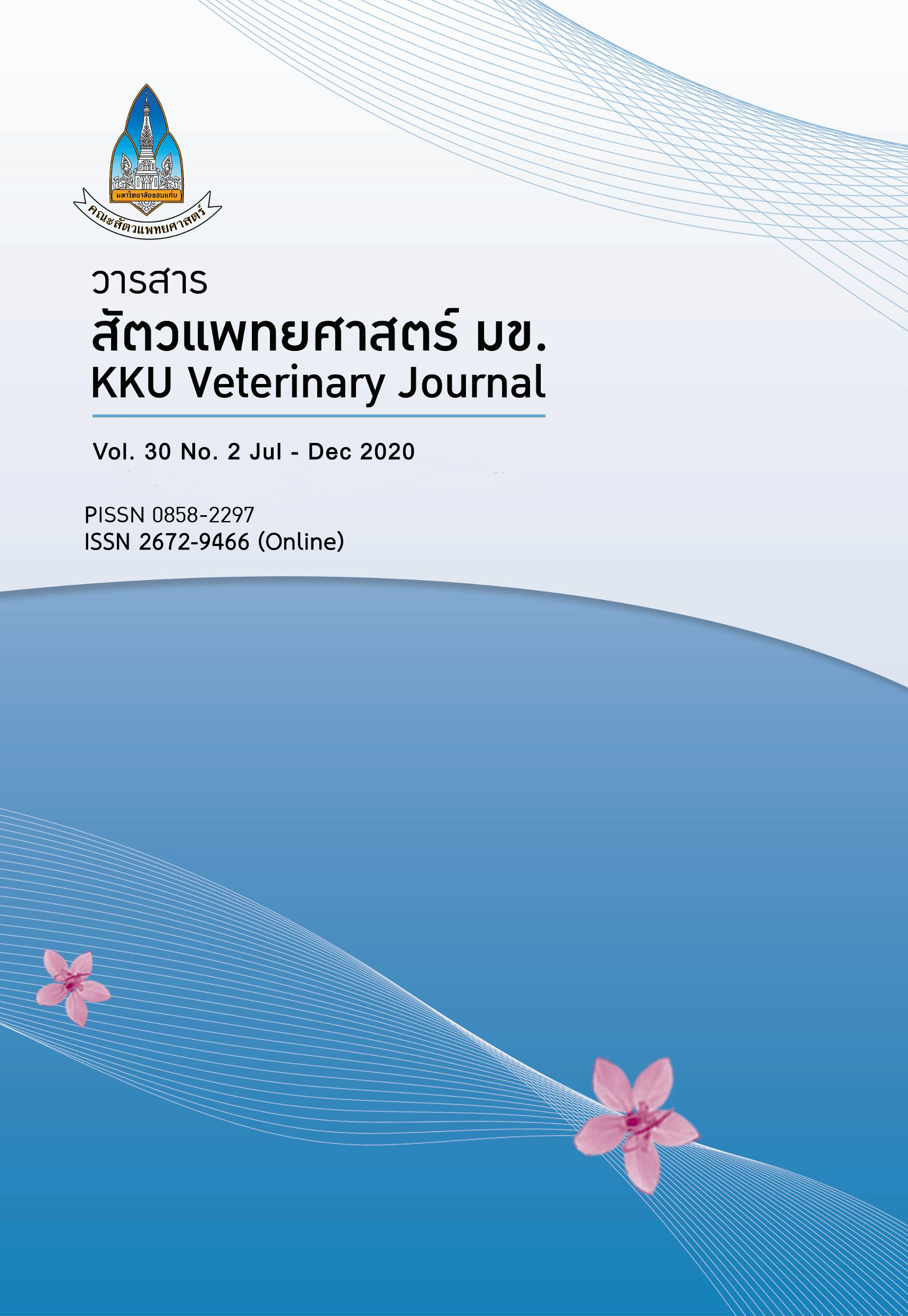การศึกษาผลการต้านจุลชีพของสารสกัดจากต้นกระพังโหม และต้นตดหมูตดหมาในการยับยั้งแบคทีเรีย และเชื้อยีสต์
Main Article Content
บทคัดย่อ
วัตถุประสงค์ เพื่อศึกษาฤทธิ์ต้านจุลชีพของสารสกัดจากต้นกระพังโหม และต้นตดหมูตดหมา ในการยับยั้งเชื้อแบคทีเรียและเชื้อรา รวมถึงหาความเข้มข้นน้อยที่สุดที่สามารถยับยั้งเชื้อได้
วัสดุ อุปกรณ์ และ วิธีการ นำต้นกระพังโหม และ ต้นตดหมูตดหมาที่ผ่านการอบแห้งและปั่นละเอียดแล้ว มาสกัดให้ได้สารสกัดจากต้นกระพังโหม และ ต้นตดหมูตดหมาด้วย 95% เอทานอล จากนั้นนำสารสกัดจากต้นกระพังโหมและต้นตดหมูตดหมามาใช้ทดสอบประสิทธิภาพในการยับยั้งเชื้อแบคทีเรียที่แยกได้จากสัตว์ป่วยและเชื้อยีสต์ ด้วยวิธี Broth microdilution method โดยมียาปฏิชีวนะเจนตามัยซิน (Gentamicin), ยาต้านเชื้อราคีโตโคนาโซล (Ketoconazole) และ Staphylococcus aureus ATCC 25923, Escherichia coli ATCC 25922 เป็นยาและเชื้อควบคุมผลการทดลอง
ผลการศึกษา กระพังโหม (Oxystelma esculentum R. Br.) มีฤทธิ์ยับยั้งเชื้อ Staphylococcus aureus ได้ดีที่สุด รองลงมาคือ S. aureus ATCC 25923, S. agalactiae, Klebsiella spp., S. hyicus, A.hydrophila, S. intermedius, P. aeruginosa, E. coli ATCC 25922 โดยมีค่าเฉลี่ย MIC คือ 0.38, 6.07±68.32, 6.07±68.32, 9.63±50.33, 12.14±67.51, 17.14±66.45, 17.14±66.45, 34.30±60.01, 48.50±51.44 มก./มล. ตามลำดับ และจากการทดสอบฤทธิ์ยับยั้งเชื้อราของสารสกัดกระพังโหม พบว่า กระพังโหม (Oxystelma esculentum R. Br.) มีฤทธิ์ยับยั้งเชื้อ C. neoformans ได้ดีกว่า C. albicans โดยมีค่าเฉลี่ยความเข้มข้นต่ำสุดที่สามารถยังยั้งการเจริญของเชื้อ คือ 6.06±12.25 and 34.29±17.15 มก./มล. ตามลำดับ เมื่อทำการทดสอบฤทธิ์ยับยั้งเชื้อแบคทีเรียของสารสกัดตดหมูตดหมา พบว่าตดหมูตดหมา (Paederia linearis Hook. f.) มีฤทธิ์ยับยั้งเชื้อ S. aureus ATCC 25923 และ S. aureus ได้ดีที่สุด รองลงมาคือ S. hyicus, S. intermedius, S. agalactiae, A. hydrophila, , E. coli ATCC 25922, Klebsiella spp., P. aeruginosa โดยมีค่าเฉลี่ย MIC คือ 0.88, 0.88, 1.05±0.45, 2.80±3.11, 8.90±15.84, 14.15, 28.31, 28.31, 28.31 มก./มล. และจากการทดสอบฤทธิ์ยับยั้งเชื้อราของสารสกัดตดหมูตดหมา พบว่าตดหมูตดหมา มีฤทธิ์ยับยั้งเชื้อ C. neoformans ได้ดีกว่า C. albicans โดยมีค่าเฉลี่ย MIC คือ 22.46±24.52 and 35.66±53.59 มก./มล. ตามลำดับ
ข้อสรุป กระพังโหม (Oxystelma esculentum R. Br.) และตดหมูตดหมา (Paederia linearis Hook. f.) สามารถยับยั้งการเจริญของเชื้อแบคทีเรียได้หลายชนิด ได้แก่ S. aureus, S. agalactiae, Klebsiella spp., S. hyicus, A. hydrophila, S. intermedius, P. aeruginosa โดยมีค่า MIC ต่างๆกัน และสามารถยับยั้งการเจริญของเชื้อรา ได้แก่ C. albicans และ C. neoformans ทั้งนี้พบว่ากระพังโหมและตดหมูตดหมามีฤทธิ์ในการต้านเชื้อแบคทีเรียและเชื้อราที่นำมาทดสอบไม่แตกต่างกันทางสถิติ (P>0.05)
Article Details
เอกสารอ้างอิง
Arinee C, Kamolchai T, Jeerasak T, Monchai D, Fanan S. 2010. Efficacy of Thai medicinal plants against Candida albicans. 48 th KU Conference, 246-251.
Arinee C, Jinda W, Thepinthitiya S, Morakod B, Lalitwadee N. 2011. Antibacterial activity of Clausena harmandiana leaf extract against pathogenic bacteria isolated from animals. KKU Vet J 21(1), 61-68.
Baanlaesuan. 2016. Paederia linearis Hook. f. root. (online) Available: http://book.baanlaesuan.com/plant-library/paederia-linearis/
Devi MK, Yogananth N. 2016. In vitro antimicrobial activity of crude and chromatographic fractions of Oxystelma esculentum (L.F) R. Br.ex Schltes. Int J Adv Res Biol Sci 3(12), 183-187.
Durairaj A, Shok KV, Thamil SM, Upal KG, Malaya. 2009. Antineoplastic and antioxidant activities of Oxystelma esculentum on Swiss albino mice bearing Ehrlich’s ascites carcinoma. Pharm Biol 47(3),195-202.
Jinda W, Suppachai T, Tararat N. 2017. Identification of some medicinal plants by HPLC technique. Thammasart University.
Medthai. 2017. Paederia linearis Hook. f. root. (online) Available: https://medthai.com/%E0%B8%95%E0%B8%94%E0%B8%AB%E0%B8% A1%E0%B8%B9%E0%B8%95%E0%B8%94%E0%B8%AB%E0%B8%A1%E0%B8%B2/
National Committee for Clinical Laboratory Standards. 2000. Methods for dilution antimicrobial susceptibility test for bacteria that grow aerobically; Approved Standard- Fifth Edition. NCCLS document M7- A5 (ISBN 1-56238-394-9). NCCLS, 940 West Vally Road, Suite 1400, Wayne, Pennsylvania 19087- 1898, USA.
Pandya DJ, Anand S. 2011. A Complete review on Oxystelma esculentum R. Br. Pharmacogsy Journal. 3(19), 87-90.
Pandya DJ, Anand S. 2011. Anti-ulcer potential of Oxystelma esculentum. Int J Green Pharm 5(1), 65-68.
Pharita S, Angkana C. 2018. Paederia linearis Hook. f. root: chemical compositions, antioxidant activity and its effect on physico-chemical properties of RD6 glutinous rice flour. Khon Kaen Agr J 46 (1), 438-444.
Quinn PJ, Carter ME, Markey BK, Carter GR. 1994. Clinical Veterinary Microbiology. Wolfe Publishing. Spain. 648p.
Rekha S, Vidyasagar GM. 2013. Anti-Candida Activity of Medicinal Plants. Int J Pharm Pharm Sci 5(4), 9-16.
Savitha G, Balamurugan S. 2014. Pharmacognostical studies on Oxystelma esculentum (L.F) R.Br. ex Schltes, a medicinal plant. Int Lett Nat Sci 22(14), 51-57.
Savitha G, Balamurugan S. 2015. Free radical scavenging, GC-MS and FT-IR analyses of different solvent extract of leaf, stem and root of Oxystelma esculentum R. Br. Life Sci Arch 1(5), 350-357.
Savitha G, Balamurugan S. 2016. Preliminary phytochemical and antimicrobial activities of different solvent leaf extracts of Oxystelma esculentum R. Br. J Chem Pharm Res 8(1), 447-451.
Sudta P, Sabyjai C, Wanirat K. 2013. Phytochemical analysis, in vitro antioxidant and cytotoxic activity of extracts of Paederia linearis Hook. F. Root. The Sci J of Phetchaburi Rajabhat University 10(1), 5-18.
Yaowapa A. 2011. Antifungal activity of plant extract against Colletotrichum gloeosporioides: anthracnose disease of Asparagus officinaris. Kasetsart University. (online) Available: http://webcache.googleusercontent.com/search?q=cache:http://www.lib.kps.ku.ac.th/SpecialProject/Agricultural_Biotechnology/2554/Bs/YaowapaAr/YaowapaArAll.pdf


